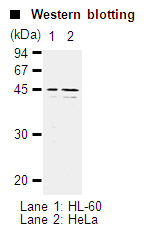Anti-Caspase-5 mAb
| Code | Size | Price |
|---|
| MBL-M060-3 | 100 ug | £296.00 |
Quantity:
Prices exclude any Taxes / VAT
Overview
Host Type: Mouse
Antibody Isotype: IgG1 κ
Antibody Clonality: Monoclonal
Antibody Clone: 4F7
Regulatory Status: RUO
Target Species: Human
Application: Western Blot (WB)
Shipping:
4°C
Storage:
-20°C
Images
Documents
Further Information
Applications:
WB - 1 ug/mL (chemiluminescence detection system)
Background:
Apoptosis is a major form of cell death characterized by several morphological features that include chromatin condensation and fragmentation, cell membrane blebbing, and formation of apoptotic bodies. These morphological changes occur via signaling pathway that leads to the recruitment and activation of caspases, a family of cysteine-containing, aspartate-specific proteases. Caspases exist as inactive proenzymes in cells and are activated through their processing into two subunits in response to apoptotic stimulation. Activated caspases cleave a variety of important cellular proteins, other caspases, and Bcl-2 family members, leading to a commitment to cell death. Caspase-10 (also known as Mch4, FLICE2 and ICE-LAP4) is a ~58 kDa protein. This caspase acts upstream of the apoptosis induced cascade. Once this caspase is activated by certain apoptotic stimuli, this protein may be responsible for the activation of the other caspases such as caspase-3, -4, -7, -8, and -9. This antibody was made against human-originated immunogen, and detects human caspase-10 specifically.
Concentration:
1 mg/mL
Formulation:
1.0 mg/mL in PBS/50% glycerol, pH 7.2
Gene IDs:
Human: 838
Immunogen Translated:
Caspase-5 recombinant terminal C (202-419 aa)
Target:
Caspase-5
References
1) Cryns, V., et al., Genes Dev. 12, 1551-1570 (1998)
2) Humke, E. W., et al., J. Biol. Chem. 273, 15702-15707 (1998)
3) Nicholson, D.W., et al., Trends Biochem. Sci. 22, 299-306 (1997)
4) Cohen, G.M., et al., Biochem. J. 326, 1-16 (1997)
5) Munday, N. A., et al., J. Biol. Chem. 270, 15870-15876 (1995)
6) Arends, M. J., et al., Int. Rev. Exp. Pathol. 32, 223-254 (1991)




